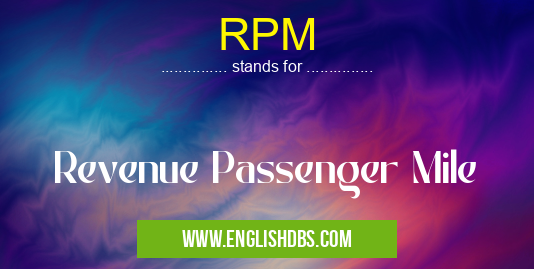What does RPM mean in TRANSPORTATION
RPM stands for Revenue Passenger Mile which is an important metric used by governmental departments such as the Department of Transport and Federal Aviation Administration (FAA) to measure the total number of miles traveled by paying passengers in aircrafts, buses, trains, and other forms of transportation. This metric is closely related to passenger-miles (PM), but where PM measures all passengers, regardless of whether they paid or not, RPM uses only those who have paid fares. As such, RPM is a more accurate reflection of the demand for services from transportation providers.

RPM meaning in Transportation in Governmental
RPM mostly used in an acronym Transportation in Category Governmental that means Revenue Passenger Mile
Shorthand: RPM,
Full Form: Revenue Passenger Mile
For more information of "Revenue Passenger Mile", see the section below.
Essential Questions and Answers on Revenue Passenger Mile in "GOVERNMENTAL»TRANSPORTATION"
What is Revenue Passenger Mile?
Revenue Passenger Mile (RPM) is a measure of airline passenger travel, calculated as the number of paying passengers multiplied by the distance flown. It is an industry standard that enables airlines to measure their performance and revenue.
How is RPM calculated?
RPM is calculated by multiplying the number of paying passengers by the total distance they have travelled. For example, if 10 passengers flew a total of 1,000 miles in one journey, then the total RPM for that journey would be 10,000.
What does an increased value of RPM mean?
An increased value of RPM generally means that more people are paying to fly with an airline, and hence more revenue will be generated from this source alone.
How can an increase in RPM help improve airline operations?
An increase in RPM indicates that more customers are flying with an airline and enjoying their experience. This improved customer satisfaction can lead to higher customer loyalty which can in turn result in greater operational efficiency and a better bottom line for the airline.
What other metrics can help indicate successful results alongside RPM?
Other important measures of success for airlines include load factor (the percentage of capacity filled), cost per available seat mile (CASM) and yield per passenger mile (YPP), all of which provide insight into how well an airline is performing financially.
What factors might negatively affect an airlines's Revenue Passenger Miles?
Factors such as poor customer service or reduced flight frequency could lead to lower numbers of passengers flying with an airline, thus reducing the number of Revenue Passenger Miles being achieved. Similarly, higher competitor prices or reduced market share could also decrease demand for air travel with a particular carrier.
Can Revenue Passenger Miles help identify trends in travel patterns?
Yes, tracking changes in Revenue Passenger Miles over time can provide valuable insight into shifts in consumer demand over different months or seasons. Once identified, these trends can inform marketing tactics and pricing strategies to ensure maximum revenue potential throughout a year for airlines.
How frequently should airlines measure their RPMs?
Airlines should monitor their ticket sales and corresponding change in RPM on at least a monthly basis so they have up-to-date information on any changes in demand or market conditions that may affect business operations.
RPM also stands for: |
|
| All stands for RPM |
